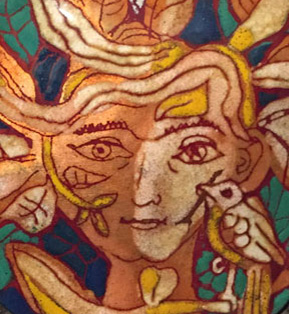Past Exhibition
Primal Nature: Animalia by Women in Post-War Claremont
Claremont Museum of Art
200 W. First Street, CA 91711
Animals, both real and fantastic, occupied an important place in artistic expression in mid- twentieth-century Claremont, appearing in the work of ceramists, painters, enamelists, and sculptors. Primal Nature: Animalia by Women in Post-War Claremont, curated by Susan M. Anderson, focuses on this phenomenon, particularly in the work of women artists who played a vital role in the development of the arts in Claremont.
The exhibition, sponsored by Gould Asset Management LLC, will be on view September 21, 2018 through January 6, 2019 at the Claremont Museum of Art, located in the historic Claremont Depot at 200 W. First Street. The museum is open Friday, Saturday and Sunday, noon to 4:00 PM, and during Art Walk, the first Saturday of every month from 6:00 to 9:00 PM.
The exhibition is generously sponsored by Gould Asset Management LLC.
About the Exhibition
Mid-century modern art, architecture, and design in Claremont were influenced by the Arts and Crafts Movement that developed in 19th-century Great Britain and flourished in the United States through the 1920s. Although the movement was multi-centered in America, the fullest expression of its ideals was to be found in Southern California. Here, with a focus on traditional craftsmanship and a lifestyle that promoted immersion in nature, artists drew sustenance from local flora and fauna, and vernacular design.
In Claremont, the ethos of the Arts and Crafts Movement lingered during the Depression era and experienced an extraordinary resurgence in the post-war period. This was due in large part to the influence of Millard Sheets and to the artists, designers, craftspeople, and architects he drew to the growing Claremont art colony beginning in 1932.
In the post-war period, Sheets’s exhibition programs at the Los Angeles County Fair included almost yearly arts and crafts shows, including the regionally important “The Arts of Daily Living” and “The Arts of Western Living.” These helped foster Claremont’s creative community, as did the Millard Sheets Studio on Foothill Boulevard where dozens of artists, craftspeople, and architects worked on landmarks, in Claremont and beyond, such as the Home Savings and Loan buildings with their signature mosaics.
Themes drawn from nature, especially animal forms, were common. Since classical antiquity, artists have assigned meaning to animals real and imagined. At the same time. animals—wild, domesticated and fantastic—often functioned for artists as creative muses or effective design solutions.
Primal Nature explores the significance of this shared theme and the context for its emergence in the work of pivotal figures in Claremont such as Jean Goodwin Ames, Betty Davenport Ford, Barbara Beretich, and Susan Hertel. The exhibition also includes works by Marjorie Burgeson, Dora de Larios, Ingrid Petersen, Hildred Reents, Martha Underwood, Nina de Creeft Ward, and Ellamarie Wooley.
Susan M. Anderson is an independent curator and art historian with a focus on the art of California. She is a former chief curator of Laguna Art Museum. Assisting the guest curator in her research, Scripps College undergraduate Linnea Rosenberg participated in the organization of this exhibition as this year’s Millard Sheets Art Intern.
About the Artists
Jean Goodwin Ames’ (1903-1986) preferred medium was enamel, but she was also a painter. Ames, who taught at Scripps College and Claremont Graduate School from 1940 to 1962, described her oeuvre as being filled with “enchanted birds and beasts.” Her commitment to enamel contributed to the recognition of the medium as an art form in the years following World War II.
Barbara Beretich’s (1936-2018) ceramic sculptures of cats, which she often finished in bronze, also recall archaic sculpture while being highly polished and stylized. From 1962 to 1965, Beretich attended Claremont Graduate School, receiving an MFA. From 1973 to 1978, she operated Gallery 8 on Harvard Avenue, and, from 1978, Galleria Beretich, located in her home. Both offered important exhibition venues for local and regional artists.
Archaic animal forms recalling Egyptian, Greek, and Romanesque styles were popular among sculptors. The ceramic anincmal sculpture of Betty Davenport Ford (b.1924) exhibits this historicizing approach. Ford aims to balae the capture of the animal’s essential spirit with sound design. She graduated from Scripps College in 1946 and remained a vital part of the community through her work with the Millard Sheets Studio.
Susan Hertel (1930-1993) mused in a poem that she was “not a person of the people tribe,” suggesting a closer kinship to the animals she often portrayed in her paintings of everyday life. Hertel received her BA from Scripps College in 1952. Working in the Millard Sheets Studio, she subsequently became chief designer and executor of murals throughout Southern California, Texas, and Arkansas, for Home Savings and Loan.
Gallery



